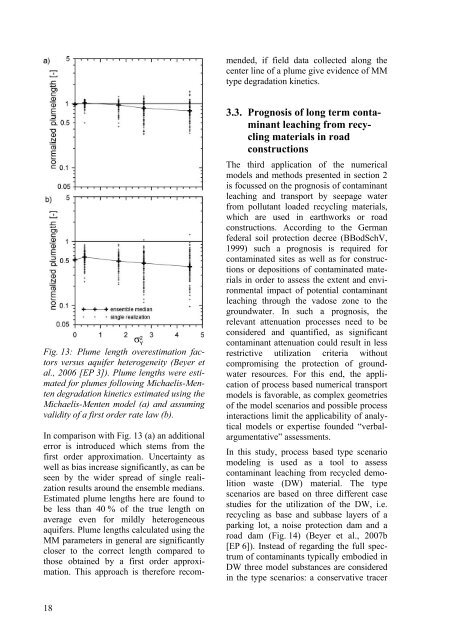Applied numerical modeling of saturated / unsaturated flow and ...
Applied numerical modeling of saturated / unsaturated flow and ...
Applied numerical modeling of saturated / unsaturated flow and ...
Create successful ePaper yourself
Turn your PDF publications into a flip-book with our unique Google optimized e-Paper software.
Fig. 13: Plume length overestimation factors<br />
versus aquifer heterogeneity (Beyer et<br />
al., 2006 [EP 3]). Plume lengths were estimated<br />
for plumes following Michaelis-Menten<br />
degradation kinetics estimated using the<br />
Michaelis-Menten model (a) <strong>and</strong> assuming<br />
validity <strong>of</strong> a first order rate law (b).<br />
In comparison with Fig. 13 (a) an additional<br />
error is introduced which stems from the<br />
first order approximation. Uncertainty as<br />
well as bias increase significantly, as can be<br />
seen by the wider spread <strong>of</strong> single realization<br />
results around the ensemble medians.<br />
Estimated plume lengths here are found to<br />
be less than 40 % <strong>of</strong> the true length on<br />
average even for mildly heterogeneous<br />
aquifers. Plume lengths calculated using the<br />
MM parameters in general are significantly<br />
closer to the correct length compared to<br />
those obtained by a first order approximation.<br />
This approach is therefore recom-<br />
18<br />
mended, if field data collected along the<br />
center line <strong>of</strong> a plume give evidence <strong>of</strong> MM<br />
type degradation kinetics.<br />
3.3. Prognosis <strong>of</strong> long term contaminant<br />
leaching from recycling<br />
materials in road<br />
constructions<br />
The third application <strong>of</strong> the <strong>numerical</strong><br />
models <strong>and</strong> methods presented in section 2<br />
is focussed on the prognosis <strong>of</strong> contaminant<br />
leaching <strong>and</strong> transport by seepage water<br />
from pollutant loaded recycling materials,<br />
which are used in earthworks or road<br />
constructions. According to the German<br />
federal soil protection decree (BBodSchV,<br />
1999) such a prognosis is required for<br />
contaminated sites as well as for constructions<br />
or depositions <strong>of</strong> contaminated materials<br />
in order to assess the extent <strong>and</strong> environmental<br />
impact <strong>of</strong> potential contaminant<br />
leaching through the vadose zone to the<br />
groundwater. In such a prognosis, the<br />
relevant attenuation processes need to be<br />
considered <strong>and</strong> quantified, as significant<br />
contaminant attenuation could result in less<br />
restrictive utilization criteria without<br />
compromising the protection <strong>of</strong> groundwater<br />
resources. For this end, the application<br />
<strong>of</strong> process based <strong>numerical</strong> transport<br />
models is favorable, as complex geometries<br />
<strong>of</strong> the model scenarios <strong>and</strong> possible process<br />
interactions limit the applicability <strong>of</strong> analytical<br />
models or expertise founded “verbalargumentative”<br />
assessments.<br />
In this study, process based type scenario<br />
<strong>modeling</strong> is used as a tool to assess<br />
contaminant leaching from recycled demolition<br />
waste (DW) material. The type<br />
scenarios are based on three different case<br />
studies for the utilization <strong>of</strong> the DW, i.e.<br />
recycling as base <strong>and</strong> subbase layers <strong>of</strong> a<br />
parking lot, a noise protection dam <strong>and</strong> a<br />
road dam (Fig. 14) (Beyer et al., 2007b<br />
[EP 6]). Instead <strong>of</strong> regarding the full spectrum<br />
<strong>of</strong> contaminants typically embodied in<br />
DW three model substances are considered<br />
in the type scenarios: a conservative tracer

















